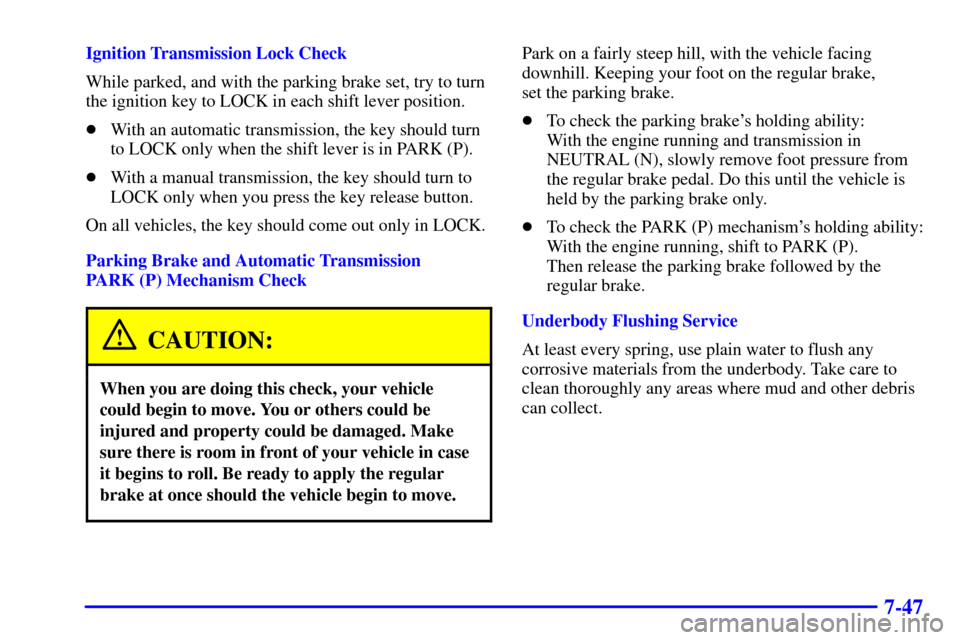Page 218 of 407

4-40
Dust or dirt can enter the back of the transmission
through the opening created by removing the propeller
shaft if proper protection is not provided. Also, check
the transmission fluid level before driving the vehicle.
When towing your vehicle, turn the ignition to OFF.
To prevent your battery from draining while towing,
remove the RDO BATT and CLSTR fuses from the
instrument panel fuse block. Be sure to replace the fuse
when you reach your destination. See ªFuses and Circuit
Breakersº in the Index.
Be sure to use the proper towing equipment designed for
recreational vehicle towing. Follow the instructions for
the towing equipment.Loading Your Vehicle
The Certification/Tire label is found on the driver's door
edge, above the door latch. The label shows the size of
your original tires and the inflation pressures needed to
obtain the gross weight capacity of your vehicle. This is
called the Gross Vehicle Weight Rating (GVWR). The
GVWR includes the weight of the vehicle, all occupants,
fuel, cargo and trailer tongue weight, if pulling a trailer.
Page 237 of 407

5-4
2. Get the vehicles close enough so the jumper cables
can reach, but be sure the vehicles aren't touching
each other. If they are, it could cause a ground
connection you don't want. You wouldn't be able to
start your vehicle, and the bad grounding could
damage the electrical systems.
To avoid the possibility of the vehicles rolling, set
the parking brake firmly on both vehicles involved in
the procedure. Put an automatic transmission vehicle
in PARK (P) and a manual transmission vehicle
in NEUTRAL.
3. Turn off the ignition on both vehicles. Unplug
unnecessary accessories plugged into the cigarette
lighter, or accessory power outlets, if you have this
option. Turn off all lamps that aren't needed as well
as radios. This will avoid sparks and help save both
batteries. In addition, it could save your radio!
4. Open the hoods and locate the batteries. Find
the positive (+) and negative (
-) terminals on
each battery.
CAUTION:
Using a match near a battery can cause battery
gas to explode. People have been hurt doing this,
and some have been blinded. Use a flashlight if
you need more light.
Be sure the battery has enough water. You don't
need to add water to the ACDelco� battery
installed in every new GM vehicle. But if a
battery has filler caps, be sure the right amount
of fluid is there. If it is low, add water to take
care of that first. If you don't, explosive gas could
be present.
Battery fluid contains acid that can burn you.
Don't get it on you. If you accidentally get it in
your eyes or on your skin, flush the place with
water and get medical help immediately.
Page 331 of 407
6-66
Fuse/Circuit
BreakerUsage
3 Cruise Control, Body Controls
TBC, Cruise Module,
Cruise Switch
4 Gages, Body Controls TBC,
Instrument Panel Cluster,
B+ Power
5 Parking Lamps, Power Window
Switch, TBC, Ashtray Lamp
6 STR WHL ILLUM
7 Headlamp Switch, Body Controls
TBC, Headlamp Relay
8 Courtesy Lamps, Inadvertent
Power Relay
9 HVAC Control Head
10 Turn Signal
11 Instrument Panel Cluster,
Engine ControlsFuse/Circuit
BreakerUsage
12 Interior Illumination
13 Auxiliary Power
14 Power Locks
15 4WD Switch, Engine Control
(VCM, PCM, Transmission)
16 Supplemental Inflatable Restraint
17 Front Wiper
18 STR WHL RDO IGN
19 Radio Battery
20 AMPF
21 HVAC I, HVAC Control Head,
HVAC Devices
22 Anti
-Lock Brakes
23 Rear Wiper
24 Radio, Ignition
Page 385 of 407

7-47
Ignition Transmission Lock Check
While parked, and with the parking brake set, try to turn
the ignition key to LOCK in each shift lever position.
�With an automatic transmission, the key should turn
to LOCK only when the shift lever is in PARK (P).
�With a manual transmission, the key should turn to
LOCK only when you press the key release button.
On all vehicles, the key should come out only in LOCK.
Parking Brake and Automatic Transmission
PARK (P) Mechanism Check
CAUTION:
When you are doing this check, your vehicle
could begin to move. You or others could be
injured and property could be damaged. Make
sure there is room in front of your vehicle in case
it begins to roll. Be ready to apply the regular
brake at once should the vehicle begin to move.
Park on a fairly steep hill, with the vehicle facing
downhill. Keeping your foot on the regular brake,
set the parking brake.
�To check the parking brake's holding ability:
With the engine running and transmission in
NEUTRAL (N), slowly remove foot pressure from
the regular brake pedal. Do this until the vehicle is
held by the parking brake only.
�To check the PARK (P) mechanism's holding ability:
With the engine running, shift to PARK (P).
Then release the parking brake followed by the
regular brake.
Underbody Flushing Service
At least every spring, use plain water to flush any
corrosive materials from the underbody. Take care to
clean thoroughly any areas where mud and other debris
can collect.